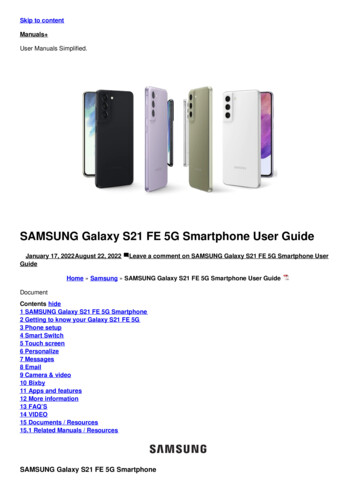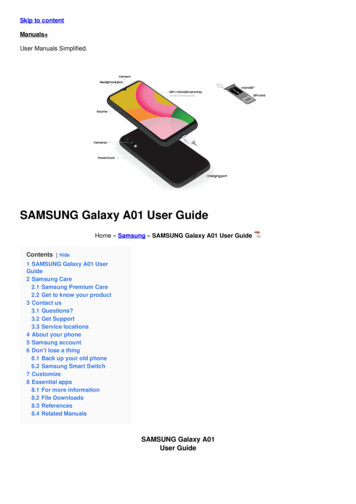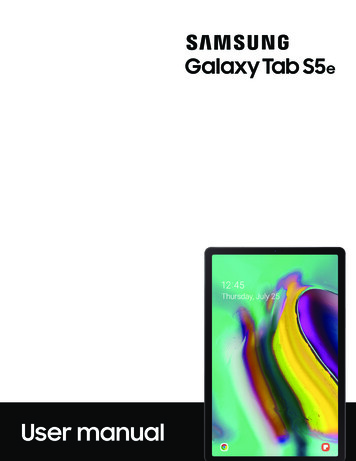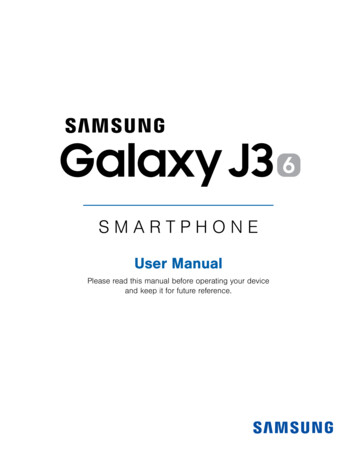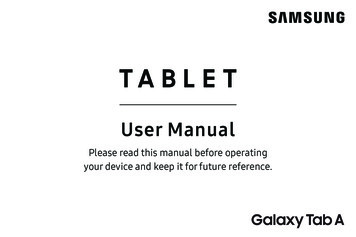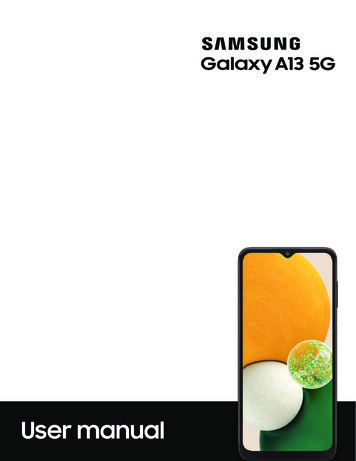
Transcription
User manual
ContentsFeaturesBiometric security Dark modeGetting startedDevice layout: Galaxy A13 5GSet up your device: Charge the batteryStart using your device: Turn on your device Use the Setup Wizard Bring data froman old device Lock or unlock your device Accounts Set up voicemail Navigation Navigation bar Customize your home screen Digital wellbeing and parentalcontrols Biometric security Mobile continuity Multi window Edge panels Entertext Emergency modeCustomize your home screen: App icons Wallpaper Themes Icons Widgets Homescreen settings Status bar Notification panel Quick settingsCamera and GalleryCamera: Navigate the camera screen Configure shooting mode Record videos Camera settingsGallery: View pictures Edit pictures Play video Edit video Share pictures andvideos Delete pictures and videos Group similar images Take a screenshotSamsung appsGalaxy Essentials Galaxy Store Galaxy Wearable Game Launcher SamsungFree Samsung Global Goals Samsung Members SmartThings Calculator Calendar Clock Contacts Internet Messages My Files Phone SamsungHealth Samsung Notes2SAM A136 EN UM TN UJ4 111721 FINAL
ContentsGoogle appsChrome Drive Duo Gmail Google GPay Maps Photos Google Play Movies &TV Play Store YouTube YT MusicMicrosoft appsOutlook Office OneDriveSettingsConnections: Wi-Fi Bluetooth NFC and payment Airplane mode Mobile networks Data usage Mobile hotspot Tethering Nearby device scanning Connect to aprinter Virtual Private Networks Private DNS EthernetCustomization: Display Notifications Sounds and vibrationSecurity: Lock screen and security Face recognition Fingerprint scannerAccounts: Add an account Account settings Remove an account Backup andrestore Google settingsBackup: Google Account External storage transferAccessibility: Recommended for you TalkBack Visibility enhancements Hearingenhancements Interaction and dexterity Advanced settings Installed services About Accessibility Contact usOther: Help Android Auto Dual Messenger Quick share About phoneLearn moreLegal information3
Getting startedGalaxy A13 5GSet up your deviceStart using your device4
Getting startedGalaxy A13 5GMicrophoneFlashRear camerasFront cameraSIM/microSDcard trayVolume keysSide key/FingerprintscannerHeadphonejackSpeakerUSB charger/Accessory portDevices and software are constantly evolving — the illustrations you see here are for reference only.5
Getting startedSet up your deviceCharge the batteryYour device uses a nano-SIM card. A SIM card may be preinstalled, or you may be ableto use your previous SIM card. Network indicators for 5G service are based on yourcarrier’s specifications and network availability. Contact your carrier for moredetails.Install SIM/microSD cardSIMPlace the SIM card andoptional microSD card(sold separately) into thetray with the gold contactsfacing down.microSDCharge your deviceBefore turning on yourdevice, charge it fully.Devices and software are constantly evolving — the illustrations you see here are for reference only.6
Getting startedNOTE Use only Samsung-approved chargers and cables. To avoid injury ordamage to your device, do not use incompatible, worn or damaged batteries,chargers or cables. Using other charging devices and batteries may void yourwarranty and may cause damage. For more information on your device,including charging compatibility, please visit samsung.com.Charge the batteryYour device is powered by a rechargeable battery.TIP While charging, the device and the charger may become hot and stopcharging. This usually does not affect the device’s lifespan or performance and isin the device’s normal range of operation. Disconnect the charger from thedevice and wait for the device to cool down. For more information, rt using your deviceTurn on your device Use the Setup Wizard Bring data from an old device Lock orunlock your device Accounts Set up voicemail Navigation Navigation bar Customize your home screen Digital wellbeing and parental controls Biometricsecurity Mobile continuity Multi window Edge panels Enter text Emergency modeTurn on your deviceUse the Side key to turn your device on. Do not use the device if the body is crackedor broken. Use the device only after it has been repaired. Press and hold the Side key to turn the device on. To turn the device off, press and hold the Side key Confirm when prompted. To restart your device, press and hold the Side key Confirm when prompted.7Power off.Restart.
Getting startedNOTE Best 5G performance requires optimal 5G connection and unobstructedantennas (rear of device); see carrier for network availability; 5G performancemay be impacted by a case or cover.Use the Setup WizardThe first time you turn your device on, the Setup Wizard guides you through the basicsof setting up your device. Follow the prompts to choose a default language, connect to a Wi-Fi network, set upaccounts, choose location services, learn about your device’s features, and more.Bring data from an old device Download Smart Switch to transfer contacts, photos, music, videos, messages,notes, calendars, and more from your old device. Smart Switch can transfer yourdata via USB cable, Wi-Fi, or computer.Visit samsung.com/smartswitch for more information.1. From Settings, tapAccounts and backup Bring data from old device.2. Follow the prompts and select the content to transfer.8
Getting startedLock or unlock your deviceUse your device’s screen lock features to secure your device. By default, the devicelocks automatically when the screen times out. For more information about screenlocks, see Lock screen and security.Side keyPress to lock.Press to turn on thescreen, and thenswipe the screen tounlock it.AccountsSet up and manage your accounts.TIP Accounts may support email, calendars, contacts, and other features.Contact your carrier for more information.Devices and software are constantly evolving — the illustrations you see here are for reference only.9
Getting startedAdd a Google AccountSign in to your Google Account to access your Google Cloud Storage, apps installed from your account, and make full use of your device’s Android features.When you sign in to a Google Account and set a Lock screen, Google DeviceProtection is activated. This service requires your Google Account information whenresetting to factory settings. For more information, see Google Play Protect.1. From Settings, tap2. TapAccounts and backup Manage accounts.Add account Google.Add a Samsung accountSign in to your Samsung account to access exclusive Samsung content and make fulluse of Samsung apps. From Settings, tap Samsung account.Add an Outlook account Sign in to your Outlook account to view and manage email messages.1. From Settings, tap2. TapAccounts and backup Manage accounts.Add account Outlook.Set up voicemailYou can set up your voicemail service when you access it for the first time. You canaccess voicemail through the Phone app. Options may vary by carrier.1. FromPhone, touch and hold the1 key or tapVoicemail.2. Follow the tutorial to create a password, record a greeting, and record yourname.10
Getting startedNavigationA touch screen responds best to a light touch from the pad of your finger or acapacitive stylus. Using excessive force or a metallic object on the touch screen maydamage the surface of the screen and the damage will not be covered by thewarranty.TapLightly touch items to select or launch them.lTap an item to select it.lDouble-tap an image to zoom in or out.Devices and software are constantly evolving — the illustrations you see here are for reference only.11
Getting startedSwipeLightly drag your finger across the screen.lSwipe the screen to unlock the device.lSwipe the screen to scroll through the Home screens or menu options.Drag and dropTouch and hold an item, and then move it to a new location.lDrag an app shortcut to add it to a Home screen.lDrag a widget to place it in a new location.Devices and software are constantly evolving — the illustrations you see here are for reference only.12
Getting startedZoom in and outBring your thumb and forefinger together or apart on the screen to zoom in and out.lMove your thumb and forefinger apart on the screen to zoom in.lMove your thumb and forefinger together on the screen to zoom out.Touch and holdTouch and hold items to activate them.lTouch and hold a field to display a pop-up menu of options.lTouch and hold a Home screen to customize the Home screen.Devices and software are constantly evolving — the illustrations you see here are for reference only.13
Getting startedNavigation barYou may navigate your device by using either the navigation buttons or full screengestures.Recent appsBackHomeDevices and software are constantly evolving — the illustrations you see here are for reference only.14
Getting startedNavigation buttonsUse buttons along the bottom of the screen for quick navigation.1. From Settings, tapDisplay Navigation bar Buttons.2. Tap an option under Button order to choose which side of the screen the Backand Recent apps icons display.Navigation gesturesHide the navigation buttons at the bottom of the screen for an unobstructed screenexperience. Instead swipe to navigate your device.1. From Settings, tapDisplay Navigation bar Swipe gestures to enable thefeature.2. Tap an option to customize:lMore options: Choose a gesture type and sensitivity.lGesture hints: Display lines at the bottom of the screen where each screengesture is located.lShow button to hide keyboard: Show an icon on the bottom right corner ofthe screen to hide the keyboard when the device is in portrait mode.Customize your home screenThe Home screen is the starting point for navigating your device. You can place yourfavorite apps and widgets here, in addition to setting up additional Home screens,removing screens, changing the order of screens, and choosing a main Homescreen.App icons Wallpaper Themes Icons Widgets Home screen settings Status bar Notification panel Quick settingsApp iconsUse app icons to launch an app from any Home screen. From Apps, touch and hold an app icon, and tap15Add to Home.
Getting startedTo remove an icon: From a Home screen, touch and hold an app icon, and then tapRemove.NOTE Removing an icon does not delete the app, it just removes the icon from aHome screen.WallpaperChange the look of the Home and Lock screens by choosing a favorite picture, video,or preloaded wallpaper.1. From a Home screen, touch and hold the screen, and then tapWallpapers.2. Tap one of the following menus for available wallpapers: My wallpapers: Choose from featured and downloaded wallpapers. Gallery: Choose pictures and videos saved in the Gallery app. Wallpaper services: Enable additional features including guide page andDynamic Lock screen. Apply Dark mode to Wallpaper: Enable to apply Dark mode to your wallpaper. Explore more wallpapers: Find and download more wallpapers from GalaxyThemes.3. Tap a picture or video to choose it. If choosing a single picture, choose which screen or screens you want toapply the wallpaper to. Videos and multiple pictures can only be applied to the Lock screen. If choosing videos or pictures from the Gallery, tap on one or more items, andthen tap Done.4. Tap Set on Home screen, Set on Lock screen, or Set on Lock and Home screens(depending on which screens are applicable). If applying a picture from the Gallery to both the Home and Lock screens,enable Sync my edits if you want any edits made to that wallpaper to beapplied to both screens.16
Getting startedThemesSet a theme to be applied to your Home and Lock screens, wallpapers, and app icons.1. From a Home screen, touch and hold the screen.2. TapThemes, and tap a theme to preview and download it.3. TapNavigation drawer My stuff Themes to see downloaded themes.4. Tap a theme, and then tap Apply to apply the selected theme.IconsApply different icon sets to replace the default icons.1. From a Home screen, touch and hold the screen.2. TapThemes Icons, and tap an icon set to preview and download it.3. TapNavigation drawer My stuff Icons to see downloaded icons.4. Tap an icon, and then tap Apply to apply the selected icon set.WidgetsAdd widgets to your home screens for quick access to info or apps.1. From a Home screen, touch and hold the screen.2. TapWidgets, and then tap a widget set to open it.3. Swipe to the widget you want to add to the Home screen, and tap Add.Customize WidgetsOnce you have added a widget, you can customize where it's located and how itfunctions. From a Home screen, touch and hold a widget, and tap an option: Remove: Delete a widget from your screen. Settings: Customize the function or appearance of the widget. App info: Review the widget usage, permissions, and more.17
Getting startedHome screen settingsCustomize your Home and Apps screens.1. From a Home screen, touch and hold the screen.2. TapSettings to customize: Home screen layout: Set your device to have separate Home and Appsscreens, or only a Home screen where all apps are located. Home screen grid: Choose a layout to determine how icons are arranged onthe Home screen. Apps screen grid: Choose a layout to determine how icons are arranged onthe Apps screen. Folder grid: Choose a layout to determine how folders are arranged. Show Apps screen button on Home screen: Add a button to the Home screenfor easy access to the Apps screen. Lock Home screen layout: Prevent items on the Home screen from beingremoved or repositioned. Add new apps to Home screen: Automatically add newly-downloaded appsto the Home screen. Hide apps: Choose apps to hide from the Home and App screens. Return tothis screen to restore hidden apps. Hidden apps are still installed and canappear as results in Finder searches. App icon badges: Enable to show badges on apps with active notifications.You can also choose the badge style. Swipe down for notification panel: Enable this feature to open theNotification panel by swiping down anywhere on the Home screen. Rotate to landscape mode: Rotate the Home screen automatically when yourdevice’s orientation is changed from portrait to landscape. About Home screen: View version information.18
Getting startedStatus barThe Status bar provides device information on the right side and notification alerts onthe left.Status iconsBattery fullChargingMuteVibrateAirplane modeBluetooth activeLocation activeAlarmMissed callsCall in progressNew messageVoicemailNew emailDownloadUploadApp updateNotification iconsConfigure display options for the Status bar.TIP From Quick settings, tapMore options Status bar to configure settings forStatus bar notifications. For more information, see Advanced settings.19
Getting startedNotification panelFor quick access to notifications, settings, and more, simply open the Notificationpanel.Device settingsQuick settingsNotification cardsView the Notification panelYou can access the Notification panel from any screen.1. Swipe down on the screen to display the Notification panel. To open an item, tap it. To clear a single notification, drag the notification left or right.Devices and software are constantly evolving — the illustrations you see here are for reference only.20
Getting started To clear all notifications, tap Clear. To customize notifications, tap Notification settings.2. Drag upward from the bottom of the screen or tapBack to close theNotification panel.Finger sensor gesturesYou can also open or close the Notification panel by swiping up or down on thefingerprint sensor.1. From Settings, tapAdvanced features Motions and gestures Finger sensorgestures.2. Tapto enable the feature.Quick settingsThe Notification panel provides quick access to device functions using Quicksettings. The icons below show the most common settings available in Quicksettings. Icon colors change when enabled and disabled. Other settings may beavailable on your device.1. Drag the Status bar down to display the Notification panel.2. Swipe down again from the top of the screen to display Quick settings. Tap a quick setting icon to turn it on or off. Touch and hold a quick setting icon to open the setting.Wi-FiMobile dataSoundPower savingmodeBluetoothLocation21Auto rotateEye comfortshieldAirplane modeDark mode
Getting startedQuick settings optionsThe following options are available in Quick settings. Finder search: search the device. Power off: Power off, Emergency mode, and Restart options.Open settings: Quickly access the device's settings menu. More options: Reorder Quick settings or change the button layout.Devices: Control other devices when supported apps like SmartThings or GoogleHome are installed. Media: Access the Media panel and control playback of connected audio andvideo devices. Brightness slider: Drag to adjust the screen brightness.Digital wellbeing and parental controlsYou can monitor and manage your digital habits by getting a daily view of howfrequently you use apps, how many notifications you receive, and how often youcheck your device. You can also set your device to help you wind down before goingto bed. From Settings, tapDigital Wellbeing and parental controls for the followingfeatures: Tap the Dashboard to view the following:– Screen time: View how long an app has been opened and used each day.– Notifications received: View how many notifications have been receivedfrom an app each day.– Unlocks: View how many times an app has been opened each day.Your goals Screen time: Set a screen time goal and view your daily average. App timers: Set a daily limit for how long you use each app.22
Getting startedWays to disconnect Focus mode: Limit app usage for set periods of time to avoid distractionsfrom your device. Bedtime mode: Schedule when to change the screen to grayscale and mutecalls, alerts, and other sounds.Check on your kids Parental controls: Supervise your children’s digital life with Google’s FamilyLink app. You can choose apps, set content filters, keep an eye on screentime, and set screen time limits.Biometric securityUse biometrics to securely unlock your device and log in to accounts.Face recognitionYou can enable Face Recognition to unlock your screen. To use your face to unlockyour device, you must set a pattern, PIN, or password. Face recognition is less secure than Pattern, PIN, or Password. Your device couldbe unlocked by someone or something that looks like your image. Some conditions may affect face recognition, including wearing glasses, hats,beards, or heavy make-up. When registering your face, ensure that you are in a well-lit area and the cameralens is clean.1. From Settings, tapBiometrics and security Face recognition.2. Follow the prompts to register your face.Face recognition managementCustomize how face recognition works. From Settings, tapBiometrics and security Face recognition. Remove face data: Delete existing faces. Add alternative look: Enhance face recognition by adding an alternativeappearance.23
Getting started Face unlock: Enable or disable face recognition security. Stay on Lock screen until swipe: When you unlock your device with facerecognition, stay on the Lock screen until you swipe the screen. Faster recognition: Turn on for faster face recognition. Turn off to increasesecurity and make it harder to unlock using an image or video of yourlikeness. Require open eyes: Facial recognition will only recognize your face whenyour eyes are open. Brighten screen: Increase the screen brightness temporarily so that yourface can be recognized in dark conditions. About unlocking with biometrics: Learn additional information aboutsecuring your device with biometrics.Fingerprint scannerUse fingerprint recognition as an alternative to entering passwords in certain apps.You can also use your fingerprint to verify your identity when logging in to yourSamsung account. To use your fingerprint to unlock your device, you must set apattern, PIN, or password.1. From Settings, tapBiometrics and security Fingerprints.2. Follow the prompts to register your fingerprint.Fingerprint managementAdd, delete, and rename fingerprints. From Settings, tapBiometrics and security Fingerprints for the followingoptions: The list of registered fingerprints is at the top of this list. You can tap afingerprint to remove or rename it. Add fingerprint: Simply follow the prompts to register another fingerprint. Check added fingerprints: Scan your fingerprint to see if it has beenregistered.24
Getting startedFingerprint verification settingsUse fingerprint recognition to verify your identity in supported apps and actions. From Settings, tapBiometrics and security Fingerprints. Fingerprint unlock: Use your fingerprint for identification when unlockingyour device. Fingerprint always on: Scan your fingerprint even when the screen is off. Use to sign in to websites: Use your fingerprints to sign in to websites. Use with Samsung account: Use your fingerprints to verify your identityinstead of your Samsung account password. About unlocking with biometrics: Read details on the requirements eachbiometric security feature has for using your pattern, PIN, or password as abackup.Biometrics settingsConfigure your preferences for biometric security options. From Settings, tapBiometrics and security More biometrics settings for thefollowing: Show unlock transition effect: Show a transition effect when you usebiometrics to unlock your device.Mobile continuityAccess storage and other functions of your device across compatible mobiledevices and computers.Continue apps on other devicesThis feature allows you to pick up where you left off on your Galaxy devices that aresigned in to your Samsung account. The Samsung Internet and Samsung Notes appsare supported.1. From Settings, tap2. TapAdvanced features Continue apps on other devices.to turn on the feature. Connection occurs automatically.3. Sign in to your Samsung account on your Galaxy devices.25
Getting startedMulti windowMultitask by using multiple apps at the same time. Apps that support Multi window can be displayed together on a split screen. You can switch between the apps andadjust the size of their windows.Split screen control1. From any screen, tapRecent apps.2. Tap the app icon, and then tap Open in split screen view.3. Tap an app in the other window to add it to the split screen view. Drag the middle of the window border to adjust the window size.Devices and software are constantly evolving — the illustrations you see here are for reference only.26
Getting startedWindow controlsThe Window controls modify the way app windows are displayed in split screenview.1. Drag the middle of the window border to resize the windows.2. Tap the middle of the window border for the following options: Switch window: Swap the two windows. Add app combo to Edge panel: Create and add an app pair shortcut to theApps panel on the Edge screen.27
Getting startedEdge panelsThe Edge panels feature a variety of customizable panels that can be accessed fromthe edge of the screen. Edge panels can be used to access apps, tasks, and contacts,as well as view news, sports, and other information.Apps panel Configure Edge panels Edge panel position and style About Edge panels From Settings, tapDisplay Edge panels, tapto enable this feature.Edge handleSwipe to the centerof the screen toopen the Edgepanels.Apps panelYou can add apps in two columns to the Apps panel.1. From any screen, drag the Edge handle to the center of the screen. Swipe untilthe Apps panel is displayed.2. Tap an app or app pair shortcut to open it. You can also tapAll apps for thecomplete app list.lTo open additional windows in pop-up view, drag the app icon from the Appspanel to the open screen.Devices and software are constantly evolving — the illustrations you see here are for reference only.28
Getting startedTo configure Apps panel:1. From any screen, drag the Edge handle to the center of the screen. Swipe untilthe Apps panel is displayed.2. TapEdit to add other apps to the Apps panel. To add an app to the Apps panel, find it on the left side of the screen and tapit to add it to an available space on the right column. To create a folder shortcut, drag an app from the left side of the screen ontop of an app in the columns on the right. To change the order of the apps on the panel, drag each app to the desiredlocation. To remove an app, tap3. TapRemove.Back to save changes.Configure Edge panelsYou can customize the Edge panels.1. From the Edge screen, tapSettings.2. The following options are available:Checkbox: Enable or disable each panel. Edit (if available): Configure individual panels.Search: Find panels that are either installed or available to install. More options: – Reorder: Change the order of the panels by dragging them to the left orright.– Uninstall: Remove a downloaded Edge panel from your device.– Hide on Lock screen: Choose panels to hide on the Lock screen when asecure screen lock is set. Galaxy Store: Search for and download more Edge panels from GalaxyStore.3. TapBack to save changes.29
Getting startedEdge panel position and styleYou can change the position of the Edge handle. From Settings, tap Display Edge panels Handle for the following options:Edge handle: Drag to change the position of the Edge handle along theedge of the screen. Position: Choose either Right or Left to set which side the Edge screendisplays on. Lock handle position: Enable to prevent the handle position from beingmoved when touched and held. Style: Choose a color for the Edge handle. Transparency: Drag the slider to adjust the transparency of the Edge handle. Size: Drag the slider to adjust the size of the Edge handle.About Edge panelsYou can view the current software version and license information for the Edgepanels feature. From Settings, tapDisplay Edge panels About Edge panels.30
Getting startedEnter textText can be entered using a keyboard or your voice.Expand toolbarDevices and software are constantly evolving — the illustrations you see here are for reference only.31
Getting startedToolbarThe toolbar provides quick access to features of the keyboard. Options may vary bycarrier. From the Samsung keyboard, tapExpand toolbar for the following options: Emojis: Insert an emoji. Stickers: Add illustrated stickers. GIFs: Add animated GIFs. Voice input: Use Google Voice typing. Settings: Access keyboard settings. Search: Locate specific words or phrases in your conversations. Translate: Type words or sentences in the keyboard to translate them into another language. Clipboard: Access the clipboard. Text editing: Use an editing panel to help pinpoint text that you want tocut, copy, and paste. Modes: Select a keyboard layout. Keyboard size: Adjust the height and width of the keyboard.Configure the Samsung keyboardSet customized options for the Samsung keyboard. From the Samsung keyboard, tapSettings for the following options: Languages and types: Set the keyboard type and choose which languagesare available on the keyboard.– To switch between languages, swipe the Space bar left or right.32
Getting startedSmart typing Predictive text: As you type see suggested words and phrases. Suggest emojis: Include emojis when using predictive text. Auto replace: Automatically replace what you type with predictive textrecommendations. Auto spell check: Underline misspelled words in red and suggest corrections. More typing options: Customize additional typing options.Style and layout Keyboard toolbar: View or hide the keyboard toolbar. High contrast keyboard: Adjust the size of the Samsung keyboard andchange its colors to increase the contrast between the keys and thebackground. Theme: Choose a theme for your keyboard. Mode: Choose between portrait and landscape mode. Size and transparency: Adjust the size and transparency of the keyboard. Layout: Display numbers and special characters on the keyboard. Font size: Drag the slider to adjust the font size. Custom symbols: Change the symbol shortcuts on the keyboard.Other settings Swipe, touch, and feedback: Customize gestures and feedback. Select third-party content to use: Enable third-party keyboard features. Reset to default settings: Return keyboard to original settings and clearpersonalized data. About Samsung keyboard: View version and legal information for theSamsung keyboard. Contact us: Contact Samsung support through Samsung Members.33
Getting startedUse Google Voice typingInstead of typing, enter text by speaking. From the Samsung keyboard, tapVoice input and speak your text.Return to keyboardOpen SettingsDevices and software are constantly evolving — the illustrations you see here are for reference only.34
Getting startedConfigure Google Voice typingSet customized options for Google Voice typing.1. From the Samsung keyboard, tap2. TapVoice input.Settings for options. Block offensive words: Hide potentially offensive words with asterisks. Languages: Choose the language for the keyboard. Primary language: Choose a primary language if more than one language isselected.Emergency modeUse Emergency mode to access helpful emergency features and conserve yourdevice’s power during an emergency situation.To save battery power, Emergency mode: Restricts application usage to only essential applications and those you select. Turns off connectivity features and Mobile data when the screen is off.Activate Emergency modeTo activate Emergency mode:1. Press and hold the Side key.2. TapEmergency mode. When accessing for the first time, read and accept the terms and conditions.3. Tap Turn on.35
Getting s
Navigationbuttons ion. 1.FromSettings,tap Display Navigationbar Buttons. 2 .
